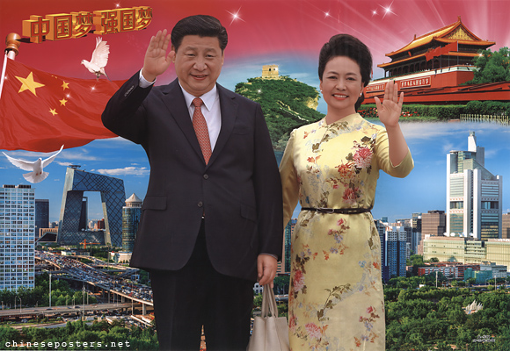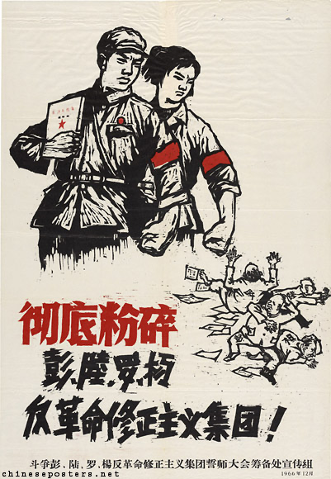Today is UN Chinese Language Day, a day ‘to celebrate multilingualism and cultural diversity as well as … equal use of all six official [UN] languages’. Of course, there’s no such thing as the Chinese language – there are hundreds. Today, there’ll be no end of blogs on the history of Chinese characters and the richness of Chinese cultures. As researchers looking at Chinese political communication, we wanted to take a different angle.
Naturally, all languages are shaped by politics. But this is especially true in the People’s Republic of China (PRC). Over the last 70 or so years, the Chinese Communist Party (CCP) has gone to great lengths to control language use. This ranges from reforms of Mandarin Chinese, the official and most widely spoken language of the PRC, to the replacing of minority languages, such as Tibetan, with Mandarin. But one of the Party’s main ways of affecting language use is through its near total dominance of public discourse. The CCP spreads persuasive messages – which we could call “propaganda” – around the PRC, and in doing so shapes the meaning of words.
Today we wanted to share some interesting things we’ve seen in our research on Chinese propaganda.

The first is the huge difference that words for similar concepts can have in different languages. The word “propaganda” in English and many other languages – including Danish – has a specific and negative meaning. It is used to refer to dishonest, manipulative communication. However, “propaganda” is usually translated into the Chinese xuanchuan 宣传 – a word with very different connotations. Xuanchuan is much more neutral and sometimes even positive. It refers to the mass spread of information. Therefore, the CCP’s propaganda work is not (publicly) regarded as negative. Instead, the Party celebrates it. It publishes numerous articles, books and social media posts about its latest campaigns and materials, and how they are received. For a long time, the CCP propaganda department’s English name was just that – the Propaganda Department. In 1998, the Party noticed the reactions that the word elicited and changed it to “Publicity”.
The desire to be perceived as more positive is in keeping with the trend of recent decades. Given the negative connotations of “propaganda”, you might think CCP propaganda would be full of repression, criticism and even violence. Indeed, such propaganda was more common in the past – such as exhortations to “smash” those who had fallen out of favour, or “kill” those with whom the PRC was at war in the early 1950s. However, nowadays such rhetoric is rare. Instead, the focus of the propaganda is on ostensibly positive things such as national pride, altruism, prosperity, taking care of the environment, personal development and so on.
As individuals familiar with these materials and their contexts, we can easily perceive this positivity. But as researchers, we want to find out if we can test this more rigorously. Can we use linguistic methods to prove that the propaganda is positive? It’s not all that easy.
When talking about positivity, negativity and other meanings of text that affect how people feel, computational linguists talk about “sentiment”. So when linguists want to find out how texts make people feel, they use “sentiment analysis”. A (very) simple sentiment analysis would involve counting the number of positive and negative words in a text and using that data to describe the text’s overall tone.
Unfortunately, there are some unique challenges with Mandarin Chinese which make sentiment analysis of CCP propaganda difficult.
For example, did you know that Chinese doesn’t use spaces between words? It’s not the only language to do so, and reading Chinese is surprisingly easy despite the lack of spaces. (That is, if you can read Chinese in the first place!) However, a clump of text without separation between words poses an obvious challenge to linguists. We have to know where words are in order to analyse their sentiment. So before beginning any sentiment analysis, we must do something called “tokenisation” – splitting up an otherwise continuous text into individual words.
So we’ve tokenised a text, and now we just have to divide the words into two lists – positive and negative. Right?
But even this is not so easy. How do we know which words are positive and negative? We could just sift through them manually, using our intuition to determine that words like “civilisation” are positive, and words like “illegal” are negative. But this would take forever! For efficiency, linguists use “sentiment dictionaries”, premade lists of words labelled with sentiments. We can sit back with a cup of tea and a biscuit while the computer uses the dictionary to analyse a text, doing our work for us, but much faster.
But with sentiment dictionaries and Mandarin Chinese, there’s a catch. A sentiment dictionary compiled in the PRC might describe certain words – such as “communism” – as positive simply because of their association with the CCP, regardless of how the average speaker of Mandarin feels about it. Meanwhile, a dictionary from Taiwan might assign “communism” to the negative list. Meanwhile, there are large numbers of Chinese-speakers outside of both the PRC and Taiwan for whom words have other associations. In other words, we can’t just take any old dictionary and use it.

Assuming we overcome these challenges, it’s important to bear in mind that language use in CCP propaganda often doesn’t reflect natural Mandarin Chinese use. Much propaganda, both written and spoken, uses formal and repetitive language full of political jargon. Even those who can’t speak Chinese can see this in the English translations of the propaganda, such as a recent article stating that ‘the whole Party needs to develop a deep understanding of the decisive significance of establishing Comrade Xi Jinping’s core position on the Party Central Committee and in the Party as a whole and establishing the guiding role of Xi Jinping Thought on Socialism with Chinese Characteristics for a New Era.’
In fact, the dryness and awkwardness of the propaganda mean that the most common reactions from Chinese-speakers are indifference, ridicule or resistance. The latter two strategies have become famous even outside of China. You might have heard that a common strategy for avoiding internet censorship is to discuss sensitive topics using homonyms – words which sound the same, of which there are a lot in Mandarin Chinese. A famous case is the word “harmony” hexie 和谐, which has instead been referred to using the word “river crab” 河蟹, which has near identical pronunciation. However, there are other smart strategies for oblique reference, such as referring to the sensitive date of June 4th (the Tiananmen Square Massacre) as “May 35th”. The invention of new terms by netizens is not, however, outside of the government’s reach. In some cases, the CCP explicitly takes the terms and casts them in positive or negative lights according to its aims. A few years ago, the idea of “lying flat”, i.e., withdrawing from the demands of society, gained international prominence. The CCP, which views this as a social and economic threat, has since published several articles denouncing the phenomenon. The word’s “sentiment” has become contended.
So bear in mind, this Chinese Language Day, as you hear all about 5000 years of history and the wisdom of the ancient script, that languages, not least of all Mandarin Chinese, are never free from the politics of the present.
Benjamin is a PhD student at Lund University researching political communication in the People’s Republic of China. Johanne is a soon-to-be former PhD student at Aarhus University who normally researches inner speech but enjoys the occasional stroll down the path of Chinese propaganda research.







Very interesting! I enjoyed reading this very much.
Oh the difficulties of linguistic research with our Western methodologies on a language with a non-Latin, non-alphabetical ideographic script and wildly different culture!